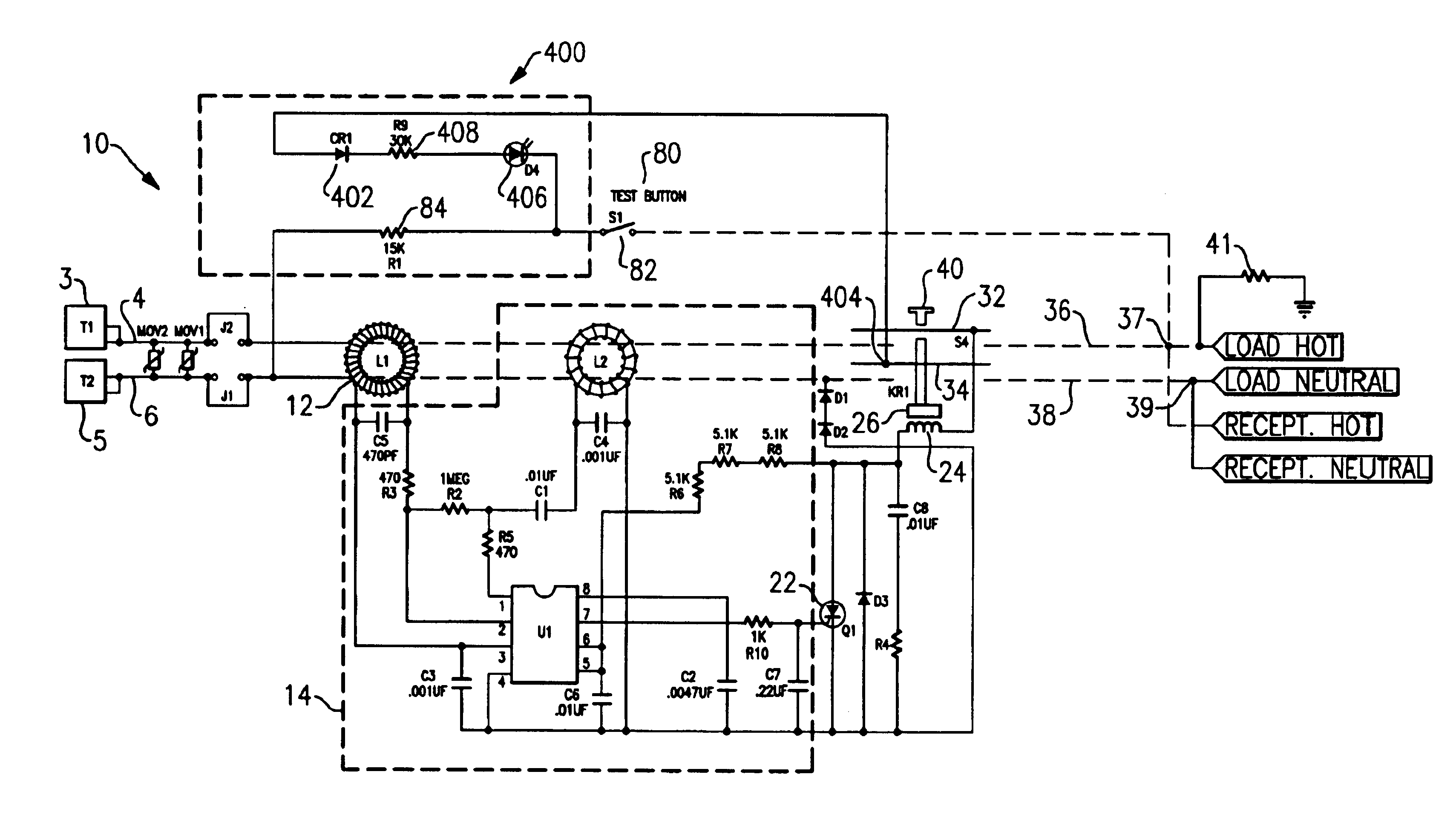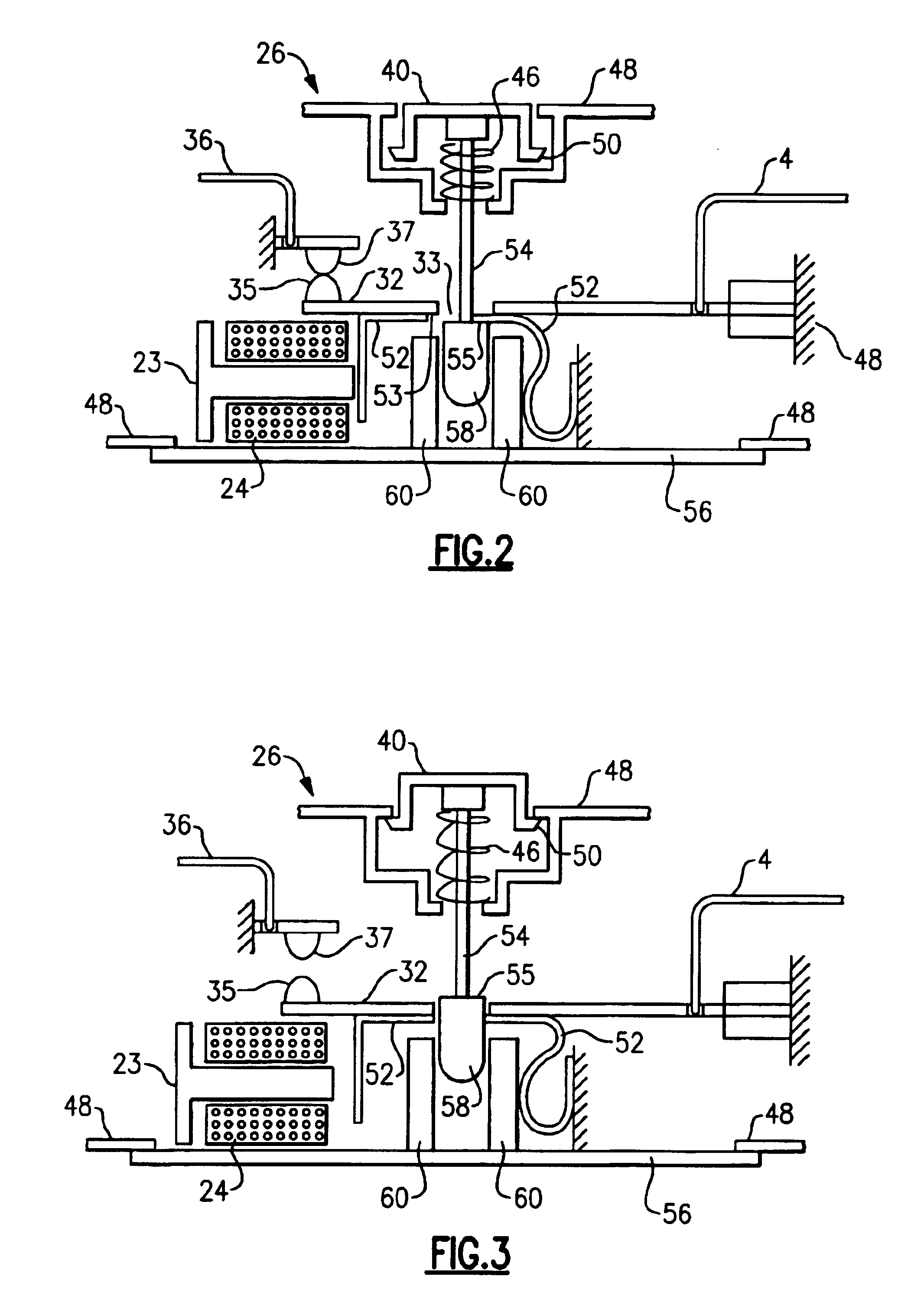Protective device with end of life indicator
a technology of protection device and indicator, which is applied in the direction of emergency protective arrangement for limiting excess voltage/current, circuit-breaking switches, instruments, etc., can solve the problems of limited current through this type of fault, parallel arc fault, and life-threatening electric shock hazards
- Summary
- Abstract
- Description
- Claims
- Application Information
AI Technical Summary
Benefits of technology
Problems solved by technology
Method used
Image
Examples
second embodiment
[0044]As embodied herein and depicted in FIG. 4, a schematic of a GFCI device 10 according to the present invention is disclosed. In this embodiment, end-of-life indicator 406 is coupled to a node 512 on an armature 32 or load side conductor 36 (not shown.) Indicator 406 is in series with SCR 510. SCR 510 is coupled to a DC voltage source provided by diode 502, resistor 504, capacitor 506 and Zener 508. Resistor 501 is coupled to contact 82 and to the gate of SCR 510. When contact 82 is closed, a difference current flows through resistor 84 as described above, and a current flows through resistor 501. The current flowing through resistor 501 produces little, or preferably no, difference current between conductors 4 and 6. Thus, any additional current through resistor 501 does not disturb UL's test simulation signal. However, the current flowing through resistor 501 causes SCR 510 to conduct. When SCR 510 conducts, end-of-life indicator 406 is energized. Under normal conditions, end-...
third embodiment
[0046]As embodied herein and depicted in FIG. 5, a schematic of a GFCI device 10 according to the present invention is disclosed. In this embodiment, end-of-life indicator 406 is coupled to transistor 602. Resistor 606 couples contact 82 to the base of transistor 602. When contact 82 is closed, the test difference current is generated, as previously described. When contact 82 is closed, the current through resistor 606 and likewise resistors 604 and 608 produce little, or preferably no difference current between conductors 4 and 6. Thus, the current through resistor 606 does not disturb UL's test simulation signal requirements. On the other hand, current through resistor 606 causes transistor 602 to turn on, to thereby energize end-of-life indicator 406. Again, under normal conditions, end-of-life indicator 406 is energized for approximately 25 milliseconds, as previously described. The indication is thus brief and unnoticeable to the user.
[0047]When device 10 fails, the current thr...
fourth embodiment
[0052]As embodied herein and depicted in FIG. 9, a schematic of a GFCI device 10 according to the present invention is disclosed. In this embodiment, end-of-life indicator 406 is in series with resistor 84 which is coupled to contact 82. The voltage drop of the end-of-life indicator 406 is configured to be less than approximately 10 Volts. Since the current through resistor 84 is typically derived from at least a 120 VAC source, the voltage drop has less than a 10% effect on the current through resistor 84. Thus, the UL requirement for the amount of simulation current are met. Diode 702 can be included in order to achieve a low voltage drop, or to protect end-of-life indicator 406 when the voltage from the electrical power distribution system has a reverse biasing polarity.
PUM
 Login to View More
Login to View More Abstract
Description
Claims
Application Information
 Login to View More
Login to View More - R&D
- Intellectual Property
- Life Sciences
- Materials
- Tech Scout
- Unparalleled Data Quality
- Higher Quality Content
- 60% Fewer Hallucinations
Browse by: Latest US Patents, China's latest patents, Technical Efficacy Thesaurus, Application Domain, Technology Topic, Popular Technical Reports.
© 2025 PatSnap. All rights reserved.Legal|Privacy policy|Modern Slavery Act Transparency Statement|Sitemap|About US| Contact US: help@patsnap.com



